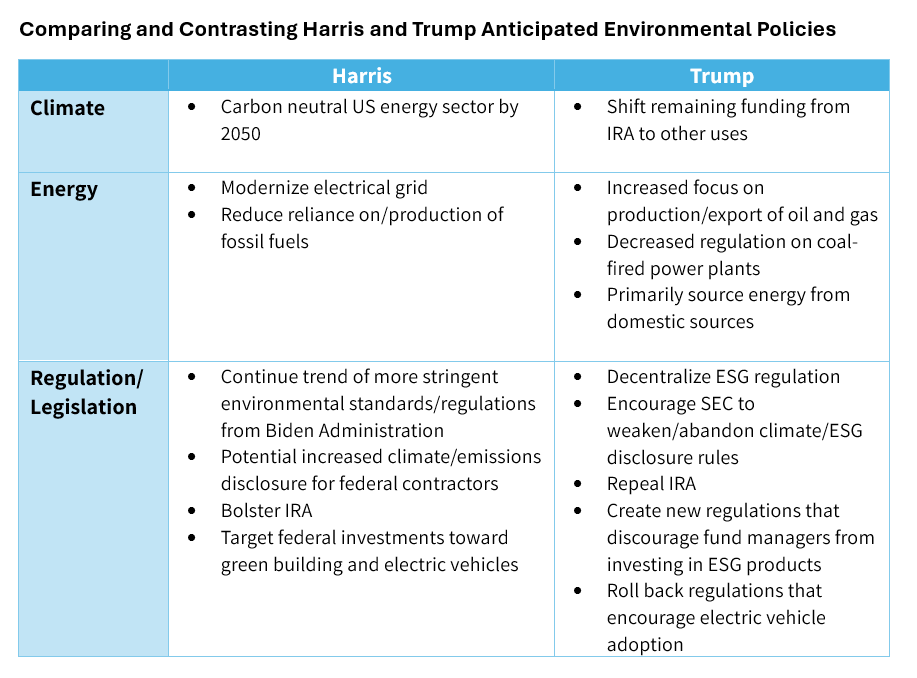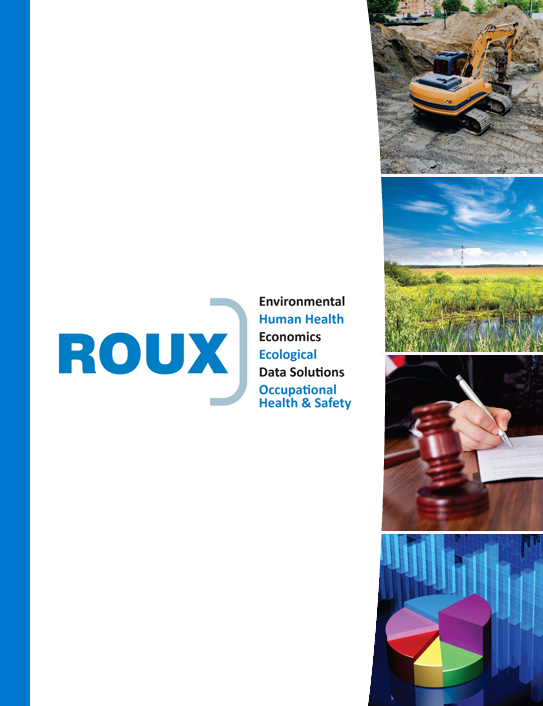How will the 2024 US Presidential Election Impact the Future of Environmental Regulation?
Over the past decade, the international community has become increasingly focused on the impact of climate change and measures to mitigate its effect on the world’s population and global environment. Countries from all over the world have entered climate accords such as the Paris Climate Agreement and other international treaties that aim to limit emissions of greenhouse gases from traditional fossil fuels and establish emission reductions that will enable the world to meet goals to preserve the planet.
The United States has sporadically participated in these multilateral endeavors and similarly has laid out plans for the country’s own sustainable future. Over the last few presidential administrations, governmental initiatives related to mitigating climate change have differed in relation to speed, scope, and implementation. As a result, the topic of climate change has become a polarizing issue in US politics as the Democratic and Republican political parties continue to offer divergent views on the of the impacts of climate change and ways government should deal with the threat to the environment.
The 2024 presidential election cycle has been nothing short of contentious. As Democratic Party candidate Kamala Harris and Republican Party candidate Donald Trump have focused much of their attention on winning voters from swing states over non-environmental issues, a lot of attention has turned away from the Environmental, Social Governance (ESG) policies of each political party. However, most recently, candidate Trump has made it clear that if he is elected for a second term, we can expect to see environmental deregulation and a rollback of the Inflation Reduction Act (IRA), which encompasses President Joe Biden’s and Vice-President Harris’ programs for environmental and energy initiatives; and an emphasis by the Trump administration on increased federal funding toward domestic energy production. On the other hand, candidate Harris has publicly stated that if she wins the election, her administration will continue and expand the programs put in place by the Inflation Reduction Act and President Joe Biden’s overall climate plan.
With the outcome of the presidential election imminent, the opposing views by Trump and Harris regarding environmental policy have shaped the current platforms of each presidential candidate. This article takes a closer look at the policy positions of both candidates; highlights their contrasting approaches to climate change, energy production, and environmental regulation; and depending on who wins, speculates the trajectory of how the US will address climate change and sustainability going forward.
Donald Trump’s Environmental Policies
The Trump presidency of 2017-2021 saw the rollback of many long-standing environmental regulations in an effort to promote economic growth. During his administration, Trump rescinded over 100 environmental regulations including repealing the Clean Power Plan and the Waters of the United States rule. He also withdrew the United States from the Paris Climate Agreement and other international climate deals. The theme of Trump’s environmental policies during his presidency was actively promoting America’s energy independence with an emphasis on fossil fuel production, including coal, oil, and fracking of natural gas. Trump supported the expansion of offshore energy activities and drilling on federal lands and rolled back regulations on methane emissions. The Trump administration characterized these measures as reflecting a broader focus on economic growth and a commitment to create a corporate environment that is not inundated by environmental compliance.
Trump has suggested that he may use the US court system and federal legislative bodies to unwind many of the environmental policy initiatives promoted by Harris, including repealing and restricting funding to many of the programs in the Inflation Reduction Act and other legislation that in Trump’s view inhibits the speed of the permitting process for energy projects.
The Supreme Court’s overturning of the 40-year-old “Chevron doctrine” earlier this year would allow courts to independently interpret whether or not a government agency has acted within its statutory authority, especially in cases where an environmentally-related statute is ambiguous, and exercise their own judgement.
Most recently, Trump has reiterated that he would like to reinstitute many of the policies from his first presidency, with a renewed focus on the oil and gas industries as well as nuclear power. Trump has said that he will slash environmental regulations that “stifle jobs, freedom, innovation and make everything more expensive.” Much of these deregulations will be aimed at ending restrictions on oil, natural gas, and coal, and will implement transparency rulemaking.
In recent remarks, Trump confirmed his support for utilizing natural gas resources. Furthermore, Trump will look to capitalize on US natural gas resources by approving significantly more liquid natural gas exports with the express goal of making the United States the “dominant energy producer in the world.” Trump has also campaigned to end existing policies that encourage closing coal power plants and boosting electric vehicle sales. It is also possible that if elected, Trump would attempt to reverse recent SEC regulations around climate disclosure and ESG.
Kamala Harris’ Environmental Policies
The Biden-Harris administration of the past 4 years was marked by several significant initiatives to address climate change and environmental issues. Of note, the US rejoined the 2015 Paris Climate Agreement (after President Trump rescinded US partnership in 2017), set targets to cut national carbon dioxide emissions by 50% by 2030 and zero-emissions targets for parts of federal agencies, as well as adding new regulations on power plants and vehicles, designed to shift the country toward the use of more renewable energy and electric vehicles.
In many respects, presidential candidate Harris will be following many of the environmental initiatives put in place during Joe Biden’s time in office. These include stricter environmental standards and regulations, including more rigorous pollution limits on emissions, enforcement mechanisms surrounding carbon emissions and climate disclosure, and federal funding and oversight on the issues of environmental justice.
The Biden-Harris administration promoted enforcement mechanisms to make polluters bear the full cost of the carbon pollution and sought to require public companies to disclose climate risks and greenhouse gas emissions in their operations and supply chains. The Biden climate plan also sought to restrict federal infrastructure investment dollars to those projects that reduce climate pollution as much as possible; and target investments toward green building and infrastructure, risk mitigation research and development, and climate-resilient infrastructure design. The Biden-Harris administration has overseen the addition of jobs in “green” industries, and the SEC has worked toward implementing their long-anticipated climate disclosure and ESG regulation. In addition, Biden’s climate change plan sought to eliminate all carbon emissions from the US energy sector by 2035 and achieve carbon neutrality by 2050.
It is possible that Vice President Harris will not only stay the course of existing Biden-Harris policies such as the IRA, but expand upon them. One such possibility could be a similar bill to the 2022 Federal Supplier Climate Risks & Resilience Rule that would mandate certain federal contractors above a certain awards threshold ($50 million) to disclose Scopes 1 and 2 emissions and certain Scope 3 emissions.
Following up on the desire for increased ESG reporting standards, Harris could continue with the Biden-Harris initiatives to promote investments in renewable energy sources, especially wind and solar energy. These promotions and investments will be crucial in accelerating the Harris administration’s push toward carbon neutrality.
Conclusion
The election of either Kamala Harris or Donald Trump will assuredly set the United States on different courses in regard to climate and environmental policy. A Harris presidency will likely see a desire to further Biden-Harris initiatives, including continued and increased investment in renewable energy production, regulations on traditional fossil fuel participants, and increased focus in the widespread adoption of electric vehicles. A Trump presidency would likely attempt to roll back the IRA and other regulations on the power sector, as well as placing a renewed focus on oil and gas exploration. As is the case with American civics, who controls the House of Representatives and Senate during either a Harris or Trump presidential administration will be a critical factor in determining the extent to which these policies will be enacted.

